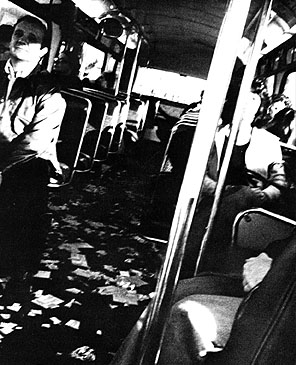RAGE ROOM
2018Full scale version of the center module for the Dream House, a seven story structure of 495 shipping containers assembled in the shape of the human brain. Included in John Duncan solo exhibition at Nicodim Gallery, Los Angeles.
Watch the video
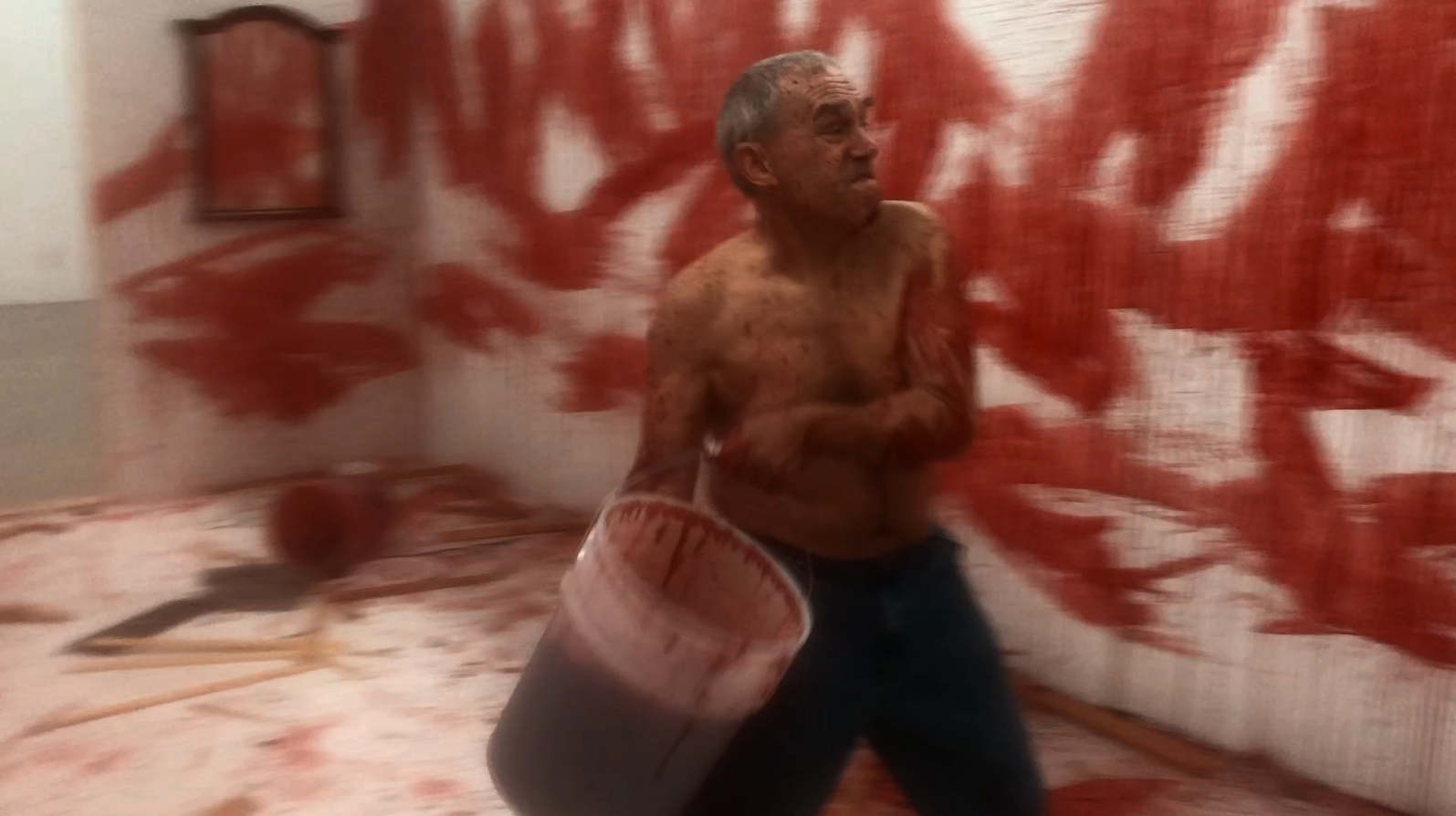
The NAZCA TRANSMISSIONS
2017NAZCA TRANSMISSIONS audio with recorded introduction by Duncan played over a custom PA system for Momentum9 Biennial: Alienation
Moss, Norway
Curated by Jacob Lillemose
Listen to an excerpt
"On Christmas Eve, 2004, John Duncan received a mysterious email from an archaeologist working at the site of the Nazca Lines in Peru. He claimed to have discovered, and over time recorded, a variety of sounds actually generated by the enigmatic lines themselves." The enigmatic archaeologist, who called himself Anton Düder, asked Duncan if he'd be interested to use the files to compose new sound works.
Duncan created a 5-track piece with the material and sent it to the mysterious archaeologist. He never heard back from him. The musician claims that a hard disk crash erased all trace of the email correspondence between them.
The artist's composition is broadcast inside an old museum theater in downtown Moss. It's an uncanny experience. I doubt anyone believes Duncan's story but what is certain is that the tracks are eerie, they left me slightly on edge, distressed and unsure the sounds were not playing with my brain. Which is a bit upsetting but also a sure sign that the artist has found his own way to translate the mystery of the ancient geoglyphs into equally perplexing auditory effects.
-- Regine

MY MALE HEART
2016Styrofoam, masonite, paper, LED, corrugated cardboard, modelling grass, wire mesh, wooden serving sticks, plywood, plastic grass carpet, orange plastic construction fencing, video projection with stereo audio
Dimensions variable
WATCH THE TRAILER
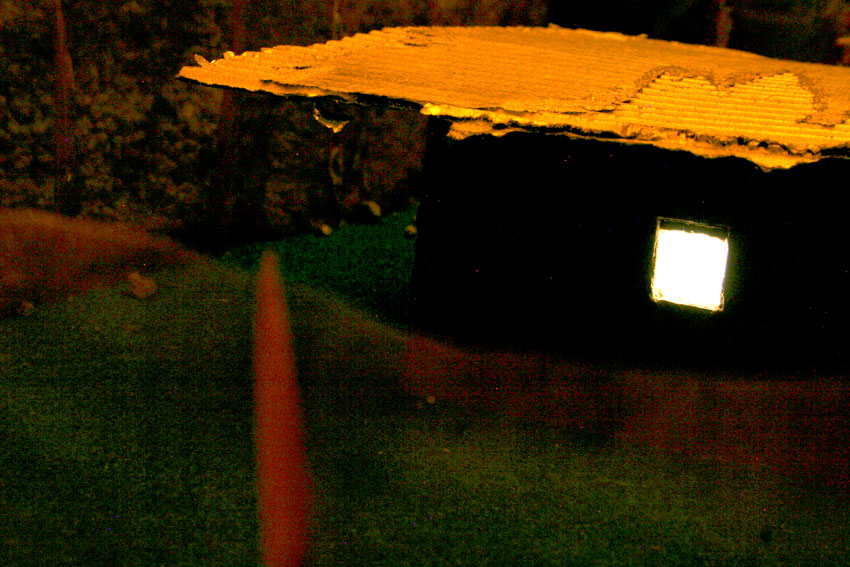
VAMPIRE RELIEF
2016Sharpened wooden stake, aluminum ladder, handwritten A4 label
Dimensions variable

Detail. Photos © John Duncan

HOPE GONE LOVE GONE
31 October - 04 November 2014Liebig12, Berlin
Curated by Allegra Solitude
Black lights, strobes, whispered voice
Words by The Four Tops
WATCH THE VIDEO
Now if you feel that you can't go on
Because all of your hope is gone
And your life is filled with much confusion
Until happiness is just an illusion
And your world around is crumbling down
Reach out ... reach on out for me
Reach out for me
I'll be there with a love that will shelter you
I'll be there with a love that will see you through
When you feel lost and about to give up
Cause your life just ain't good enough
And you feel the world has grown cold
And you're drifting out all on your own
And you need a hand to hold
Reach out ... reach out for me
Reach out for me
I'll be there to love and comfort you
And I'll be there to cherish and care for you
I'll be there to always see you through
I'll be there to love and comfort you
I can tell the way you hang your head
You're not in love now, now you're afraid
And through the tears you look around
But there's no piece of mind to be found
I know what your thinking
You're alone now, no love of your own
Reach out ... reach out for me
just look over your shoulder
I'll be there to give you all the love you need
And I'll be there you can always depend on me
I'll be there to always see you through
I'll be there to love and comfort you
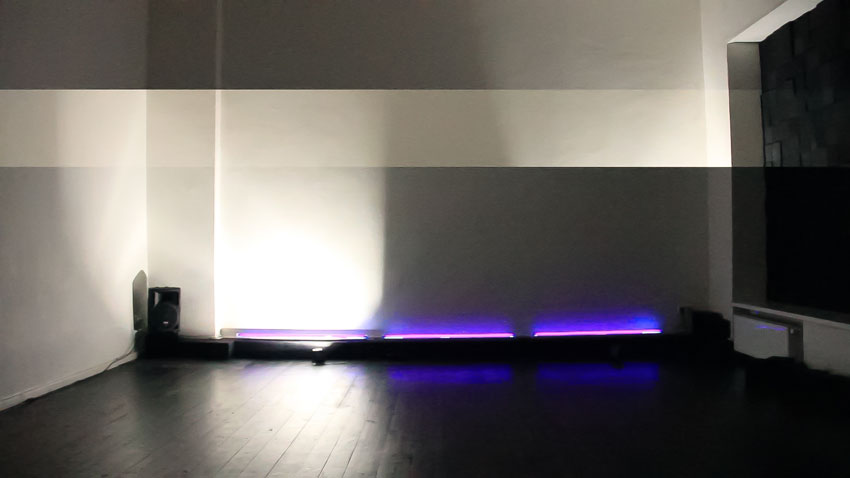
DOWNHILL
26 September - 04 October 2014A Space, Berlin
Included in Peninsula DotLand
Curated by Flatform
Room A
Video projection with soundtrack audio
WATCH THE VIDEO
Room B
Words scratched into black paint on windows
Subwoofer-only audio
A CONTEMPORARY SLAVE TALKS TO THE MIRROR
You always have been, and always will be, a loser.
You're taking up space, taking up air.
Leave room for others who succeed.
Everyone who ever cared for you regrets it.
You deserve contempt -- every bit.
You are evil. Pathetic.
You are a parasite.
Get off the planet.
Rid us of your presence.
Hang yourself.
Cut your throat.
Slash your wrists.
Die now.
Die now.
Die now.

MOLD PAINTINGS
19 October - 17 November 2012Included in AL QUARTO GIORNO NON SI RISORGE (apologia della muffa)
ON THE FOURTH DAY IT DOES NOT REVIVE (in defense of mold)
melepere arte contemporanea, Verona
Curated by Stefano Rovatti, Patrizia Silingardi, Sonia Schiavone
Artworks and installations created from mold by John Duncan, Adriano Persiani, Katharina Dieckhoff, Stefano W. Pasquini, Christian Rainer, Chiara Soldati, Ascanio Tacconi, Karin Andersen, Mustafa Sabbagh, Silvia Giachello, TTzoi, Matteo Serri, Silvio Macini, Otolab, Andrea Bruno, Irene Maccagnani, Enrica Berselli, Simone Rondelet
With the participation of FranKo B, Vicky Roditis, Dario Parisini Interzona, Mirko Fabbri, Elena Baldi
Presentation and reading from Quattro Giorni Bianchi by Stefano Rovatti (Bologna 2012, Giraldi Editore)
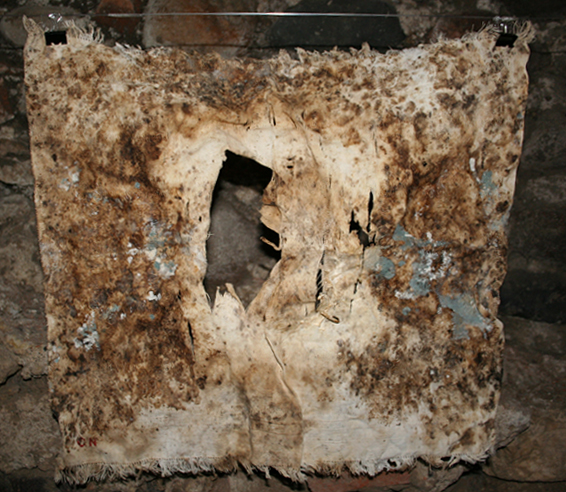
SELF-PORTRAIT in MOLD
Photo © John Duncan
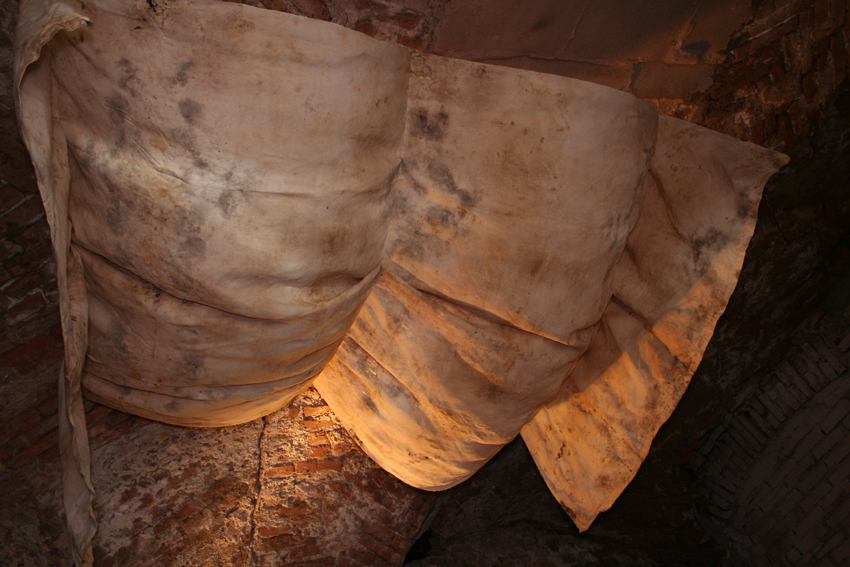
MONUMENTS-Models
02 - 19 September 2010Galerie Mario Mazzoli
Berlin
Scale models of proposed sculptures in public areas, anatomically correct castings of a human vagina increased to the sizes indicated
Model: Paola Bolignano
Inspiration and assistance from:
Accademia di Belle Arti di Bologna
Gaia Bartolini
Manuela Benetton
Nicola Boari
Federico Capitano
Noemy Cotardo
Luca Ghedini
Mario Mazzoli
Maria Clara Ruggieri Tricoli
Valerio Tricoli

Fountain
Hollow bronze or stainless steel sculpture, water pump and reservoir
Sculpture size: 10 meters x 20 meters
Photo © John Duncan
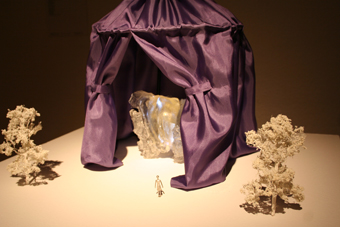
Shrine
Fiberglas sculpture filled with blinking lights, lavender satin covering aluminum tent structure topped by Jacob's Ladder crown (not shown)
Sculpture height: 8 meters
Tent height including crown: 20 meters
Photo © John Duncan
Beacon
Corningware glass tiles on stainless steel frame set in terraformed mountain
Pulsing aircraft beacon beneath
Glass tiles and frame: 20 meters x 40 meters
Photo © John Duncan

Tunnel Entry
Cast concrete
Size variable (minimum height 30 meters)
Photo © John Duncan

DREAM HOUSE - RAGE ROOM
02 - 19 September 2010Belenius Gallery, Stockholm
WATCH THE VIDEO
DREAM HOUSE: a 7 story building in the shape of a human brain, composed of interconnecting 6m x 4m x 4m modules or rooms, mounted together and held in suspension by cables extending from a central mast. Each room, such as RAGE ROOM, is designed to embody or evoke a particular state of consciousness, set in an area of the building that corresponds to its known or suspected location in the brain.

DREAM HOUSE: Lateral and top views of the overall structure
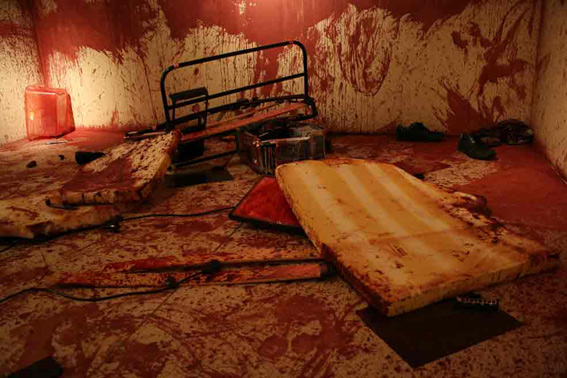
CROSSTALK POOL
23 - 25 January 2009Entry courtyard
Cineteca Lumière
Bologna
Included in Film d'artista
Curated by Lelio Aiello
Four channel audio installation with speakers mounted at various points on the roof of the complex, projecting sound to reflect off the walls of the enclosed courtyard below. Audio sources include shortwave radio transmissions, both natural and modified, mixed with voices recorded by researchers at sites reputed to be haunted.
CROSSTALK POOL turns the entire entry courtyard of the Cineteca Lumière complex into a vortex of surreal, cryptic voice messages, a chorus filtering through a constantly shifting haze of radio static.
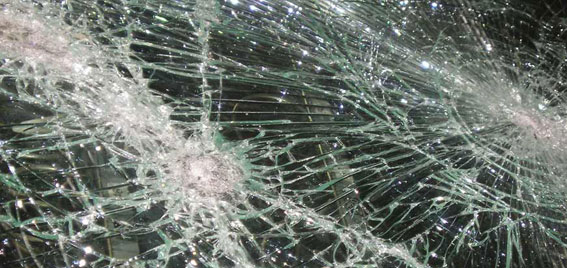
The GAUNTLET
2 February - 2 March 2008Main Hall
Färgfabriken, Stockholm
Audio installation with seven anti-theft alarms activated at intervals by infrared sensors.
Visitors navigate the total darkness via handheld penlights.
Curated by Daniel Daboczy.
50-page catalogue with writings and drawings by Duncan printed with fluorescent ink to be visible in both light and dark conditions designed by 1:2:3, produced by Färgfabriken and Gallery Niklas Belenius
Radio interview by journalist Mårten Arntzén
Learning Darkness:
John Duncan's THE GAUNTLET at Färgfabriken
-- Meredith Snyder, Vagabondish 4 March, 2008
"Only when standing in a pitch-dark room do you realize that you actually start to see. Even in the perfect darkness, there is always some kind of light." -- Daniel Daboczy
Darkness -- true darkness -- isn't something I expect to see as a city traveler, in gothic cathedrals built to lift worshipers' eyes to the heavens, or along club-lined streets at night, where cafés and dance halls glow beneath their neon marquees, and music pulses a bright night into morning. In a world obsessed with light, capturing the dance of sunlight on water in the smears of impressionist paintings, lighting glass buildings so they glow like lamps, or offering candles as tributes to its deities, we tend to forget what darkness is.
We were in Stockholm on a whim; a long weekend and a game of airfare roulette with Germanwings had taken us from Berlin's grey to Sweden's shivering damp. At the last minute, our plans were vague. We had sketched ideas from a Lonely Planet guide to Europe and a few quick internet searches. It was a whirlwind tour, a city-break; it wouldn't be a deep visit.
The one must-see stop on our list, the Färgfabriken, an avant-garde contemporary art gallery, was outside of the tourist centre of Stockholm, in an industrial area. To reach it, we trudged through the snow and ankle-deep puddles of slush, past chain-link fences and seeping brick walls, along a narrow, icy, and at that time of day, poorly lit alleyway. It seemed remote, tucked away in an alcove of industry, a paint factory built in 1889, lacking the ostentatious signs that lead to more mainstream museums, like a secret that everyone knows.
The building intrigued us as much as whatever it might be exhibiting. The Färgfabriken is a space David Byrne once turned into a musical instrument, inviting visitors to 'play the building', using the acoustics of the space to create music. The installation which opened when we were in the city was another musical experiment, but one of a different sort. John Duncan, a controversial American artist whose works skirt the boundaries of human fear, was exhibiting 'The Gauntlet,' a piece which rather than creating harmonies from the sounds of the building, interacts with the visitors' own reactions to the sound of seven-motion triggered burglar alarms, blending in a pitch dark space.
A bar table outside the door to Duncan's exhibit offered a table of flashlights, to navigate the space within. We tried one after another, never eliciting more than a flicker of light which faded as quickly as it appeared. Finally, we ducked through the curtain, armed with the plastic flashlights to defend ourselves against whatever we might find inside, rather than to light the way.
It took a minute for my eyes to adjust to the darkness, and even then, the supporting poles were more obscure than shadows on shadows, invisible until I was upon them. Along the walls, I could feel the cold roughness of the brick, but I couldn't see it. My friends called to one another, to me, looking for one another in the dark, but other than that, the only sound was cloth brushing against brick, bodies bumping into hard surfaces, fingers feeling the way. Where the darkness was deepest, I could see nothing at all, and rather than straining to catch a tiny point of light, closed my eyes.
Then the alarms began, startling, loud, then louder and louder as more were triggered. If you stopped moving, the alarms would stop, but people moved toward the exit, where the darkness wasn't so full, to get away from the noise, making it louder with each miss-step. It was terrifying, in the darkness, to be assaulted by sound. Rather than running, I paused to think about sound, and as it washed over me, a sense of exhilaration mingled with my fear.
The experience was inward, as much a display of reactions and feelings -- mine, and those of the others wading through the darkness -- as much as the sensory experience of the installation. I lay down on my back on the floor, and as the sound rolled over me, my grasping sense of fear drifted away. The cold of a floor, the roar of sirens, a shade of black I'd never seen; in Stockholm in February, in a 100-year-old factory, I learned darkness.
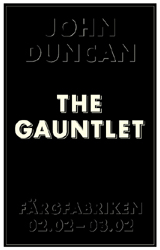
The COURTYARD
5 December 2006 - 10 January 2007Included in OPEN / CLOSE with Giovanni Morbin and Simone Menegoi
O'Artoteca, Milano
Audio installation with four channels in a specially modified room of O'Artoteca, separated from the gallery, rendered completely dark with a ceiling height of 160 cm. to make it impossible to stand upright and a carpeted floor to encourage sitting or lying prone. Visitors remove their shoes at the threshold (photo center) and enter alone. Random sounds from human activity in the O'Artoteca courtyard are recorded, then played back and re-recorded, using techniques inspired by Alvin Lucier's open reel tape work, distorting the original sounds into their resonant harmonics, and played back in the dark in a constantly random mix.
Included in OPEN / CLOSE, exhibition sponsored by O'A.I.R. artist residency program, O'Artoteca. Participants in this edition of the residency and exhibition include artist Giovanni Morbin and curator Simone Menegoi.
Produced by Sara Serighelli and Angelo Colombo.
Photo © A. Colombo
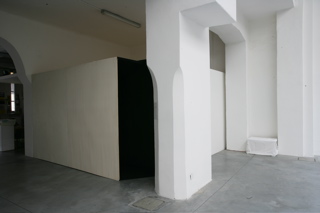
The GROTTO
30 August - 2 September, 2006Palazzo Appiano, Piombino
Audio installation with six channels in a room of the Palazzo Appiano rendered completely dark. Shortwave mixes and a consenting adult couple having long, very satisfying sex.
Included in Piombino eXperimenta 2, sponsored by the City of Piombino.
Produced by Marco Formaioni. Curated by Gianluca Becuzzi.
Photo: Participants stand in line to enter the installation
Photo © Marco Formaioni

The GARDEN
John Duncan and Valerio Tricoli15 July ~ 24 September, 2006
Audio installation with six elements based on voice and onsite field recordings, mounted inside two buildings of the IPCA Ecomuseum complex in Ciriè, Province of Turin.
Included in Eco e Narciso, sponsored by the Province of Turin.
Curated by Daniela Cascella and Rebecca de Marchi.
Details on the CD catalogue available here
IPCA (Industria Piemontese dei Colorante di Anilina) [pdf file]: originally a producer of aniline dyes, operating from the 1920's to the 1980's. Haunted by a cynicism difficult even to imagine...
Hydrochloric acid is constant inside Building 18.
All metal corroding.
Workers told to enter in pairs with no protection.
When one passes out, his partner drags him outside and returns to the job.
Workers never told what they're dealing with.
Bicycle tires leave rotting rubber on the road.
Surviving family members say over 800 employees died.
Toxic waste from the plant hauled away by tanker trucks with "milk" painted on the side.
Dumped in the river nearby.
Kilometers downstream, rocks a meter below ground stained blue, green, pink.
Tankers sequestered as evidence.
The company begins to fail.
To save it an immense incinerator is built to burn toxic waste.
Smoke released directly into the atmosphere.
-- John Duncan

Building 18
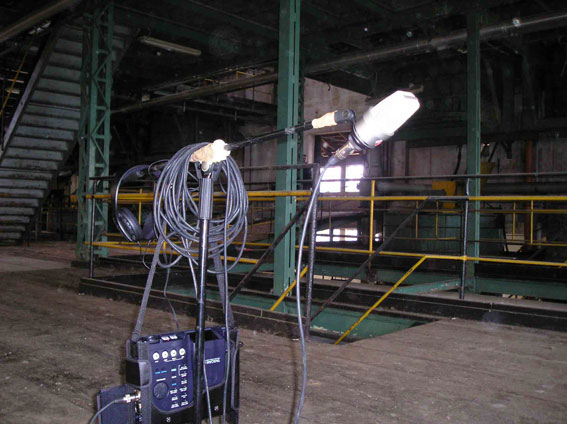
Building 18

Incinerator Building
Photos © John Duncan


The ERROR
15 April - 17 June, 2006Limited edition handprinted book and DVD video
Included in Dialogue 1
Galleria Enrico Fornello, Prato
Curated by Simone Menegoi
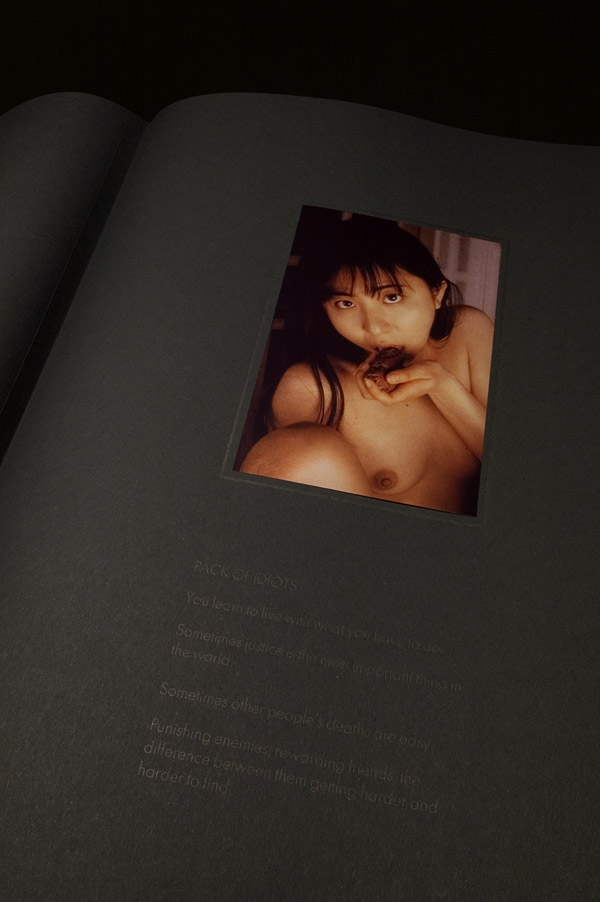
Photos © E. Bialkowska
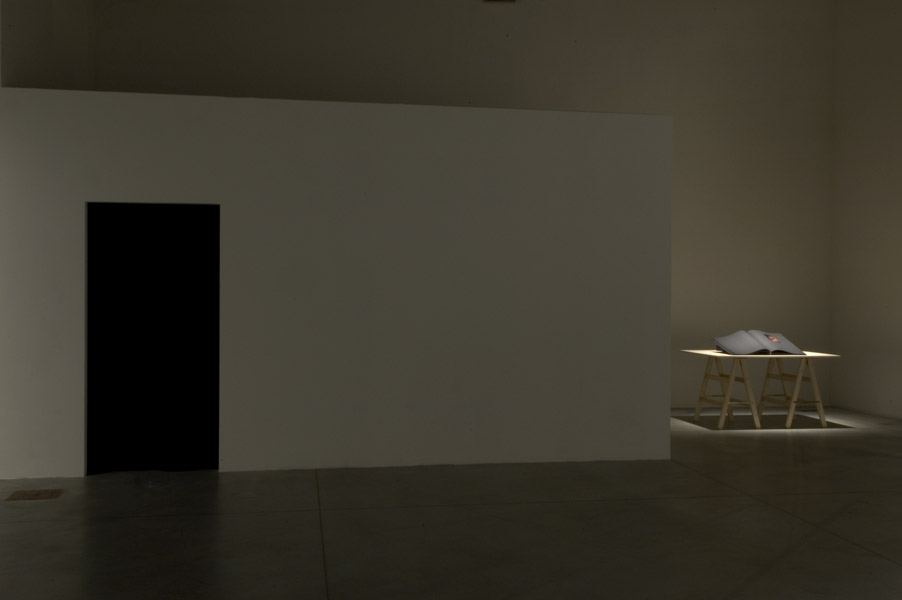
CONSERVATORY (SAN SEBASTIAN)
December, 2004 - 20 January, 2005Audio installation with Paolo Parisi
Quarter
Florence, Italy
Curated by Sergio Risaliti
Referring to the soundtrack realized for CONSERVATORY (SAN SEBASTIAN) Duncan speaks of 'phantom voices', underlining a line of research he's followed in recent years beginning with PHANTOM BROADCAST (2002), audio work and live performance where he used a shortwave radio transmission intercepted in the course of a single recording: a shadow play that takes on the aspect of bells resonating into infinity, where reverberations and traces of choruses join and fade into emptiness.
Duncan's recent works seem to audibly outline the echo of complex choral compositions, blocked from the senses, where we can taste only a reflection that thins out or thickens, as if breathing. Tension is accumulated gradually, without burning in dramatic or conclusive passages -- or better, we could speak of infinite extensions of a single climactic moment, because in the climax this work contains the pure force to unravel in a series in minimal tonal variations.
For CONSERVATORY (SAN SEBASTIAN) Duncan uses darker vocal sounds that give form to an elusive audio presence, to an ultimate ghost broadcast at the limits of human measure: again the sound is an impalpable diaphragm and necessary passage until what transcends our normal sense of listening may be perceived here in all its evocative power.
Daniela Cascella
Photos © John Duncan
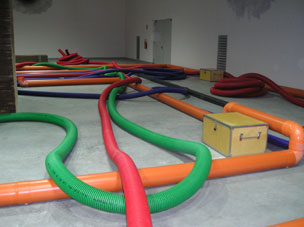
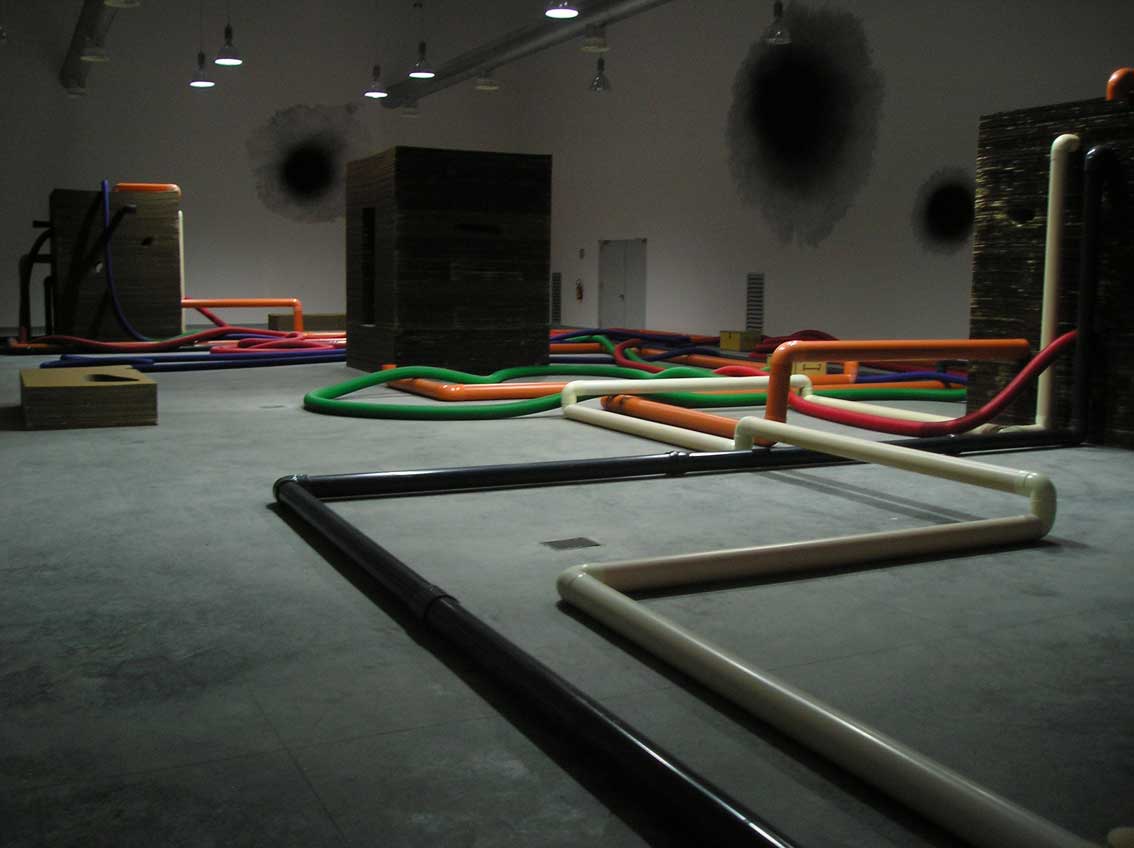
STUN SHELTER
12 September - 26 October, 2003Installation with Carl Michael von Hausswolff.
Nicola Fornello Gallery
Prato, Italy
Curated by Daniela Cascella
John Duncan's SEE is a video installation made up of four separate and simultaneous projections of sequences taken from the JOHN SEE SERIES, adult movies he directed in 1986-87 during his stay in Japan. On entering the dark exhibition space, the viewer is assailed by immense flashes of images and sound cut-ups... In those moments in which the sound is softer, a voice emerges, whispering Japanese phrases until it is drowned once again by the wave of louder sounds.
Carl Michael von Hausswolff's Thinner & Low Frequency Bar / Glue & High Frequency Lounge consists of two bars made of steel and glass on which lie bottles and cans containing volatile substances such as glue and thinner. On the bar two oscillators produce frequencies varying in intensity, whose sound penetrates the ears altering normal perception levels.
Both works fill the space perfectly, one by means of strong images (See), the other through the substances shown. The attention level is at its maximum in attempts to grasp the Japanese whispering (See) and the ghost-sounds of the oscillators (Thinner Bar...), defying the threshold of audibility as they act on the unconscious.
--Daniela Cascella
Photo © E. Bialkowska
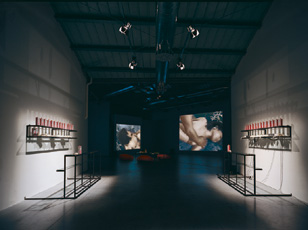 Photo © E. Bialkowska
Photo © E. Bialkowska SEE
2002John Duncan's SEE is a video installation made up of four separate and simultaneous projections of sequences taken from the John See Series, a series of adult movies he directed in 1986-87 during his stay in Japan. On entering the dark exhibition space, the viewer is assailed by immense flashes of images and sound cut-ups... In those moments in which the sound is softer, a voice emerges, whispering Japanese phrases until it is drowned once again by the wave of louder sounds.
--Daniela Cascella
Simultaneous video projections on four walls. Images and audio from the John See adult video series surround the viewer, as a voice gives suggestions in Japanese. SEE works with the elements of chaos and order, silence and sound. The video material is projected on multiple screens by random selection. The pictures and the output of the sound constantly combine together into new collages."
-- Elke Moltrecht

The KEENING TOWERS
24 May ~ 31 August, 2003AGAINST ALL EVENS
Gothenburg Biennial 2003
Gothenburg, Sweden
Curated by C.M. von Hausswolff
Outdoor audio installation with sound projected from the tops of two galvanized steel towers, each 24 meters high with separate audio systems, set up in front of the entrance to the Gothenburg art museum, playing parts of a piece composed for the installation from a children's choir conducted by Duncan in Italy.
While [Henri] Chopin was busy exploring the sounds of his own body, composers such as Karlheinz Stockhausen were seeing what could formally be done by manipulating existing voices ("Gesang der Jünglinge"). Whereas Stockhausen was a formalist-seeing how far he could push the acoustic technology in the work-the younger composer John Duncan takes a radical turn toward subjectivity and emotion for his installation The Keening Towers. Using audio systems mounted at the tops of enormous steel towers, the source of the piece is a 30-voice Italian children's choir.
Duncan states that, "The personal motivation for this project is to make a small gesture to give something back to kids, especially infants, that I've seen in my life who were victims of abuse by adults... I don't think it really matters whether 'The Keening Towers' communicates this aspect to anyone else-I'm satisfied that it works on this level for me whenever I hear the whispers, screams, etc., all made by kids having fun with their voices, moving as if they're coming down out of the wind, at times whispering directly into my ear, at other moments morphing into sexual groans that for several seconds sound as if they're being made by an adult couple hidden behind the museum façade." It's hard to image Stockhausen making such a statement.
--Kenneth Goldsmith
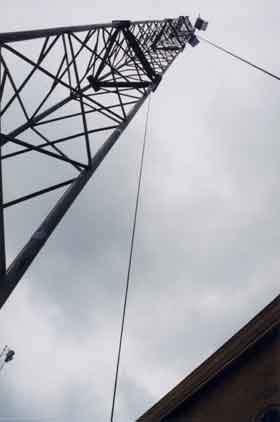

All photos © Giuliana Stefani
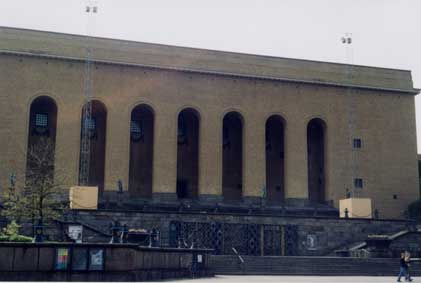
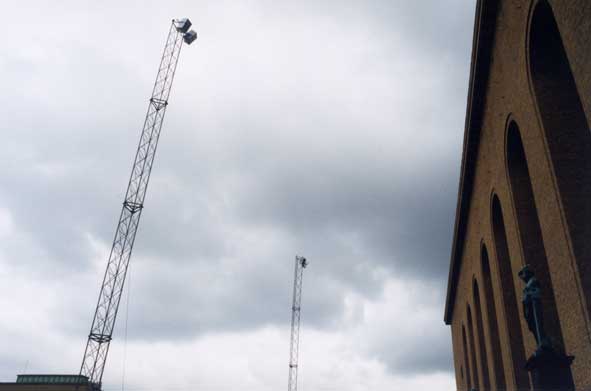
The KEENING TOWER
17 - 29 August, 2004Audio installation with sound projected from the windows of the tower at Villa Clementi, Malo, playing a piece composed for the installation from a children's choir conducted by Duncan in Italy.
Azioni inClementi 2004
Malo, Italy
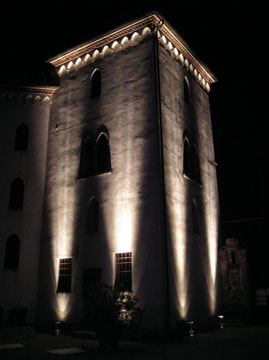
The FLOCKING
9 September - 5 October, 2000Main gallery and basement
Malacarne
Verona, Italy
In the main gallery, painted black:
A human tooth encased in a lighted plexiglas box, mounted on a pedestal that emits stereo audio. Text of a dream (in English and Italian) and the transcript of HAPPY HOMES on the rear wall.
In the basement:
A 30-voice children's choir with one soloist, heard in near-total darkness via hidden multichannel audio sources.
Sunday 7 May, 2000
Beyond Baroque, Los Angeles
A children's choir for 30 voices and one 6 year old soloist
An audio installation in near-total darkness

ACCESS DENIED
16 - 27 June, 2000Main stairway and upper floor
Villa Venier
Sommacampagna, Verona
Curated by Alessandro d'Ambrosi
Stereo sound coming from behind the locked doors of two separate rooms at the top of the villa's main stairway (one channel per room): a couple whispering, laughing, shouting, having long, slow, repeated sex, with a mixed-shortwave drone in the background, playing back loud enough to echo through the area and be heard from the base of the stairs, encouraging visitors to defy the 'ACCESS DENIED' sign on the staircase steps and go up to hear better. Which of course they did.
Photo © Giuliana Stefani

VOICE CONTACT
11 December, 1999 - 31 January, 2000Installation and remains from the event with one participant at a time, entering voluntarily and nude into a completely dark, empty room.
Watari Museum of Contemporary Art, Tokyo
Curated by Thomas Nordanstad and Koichi Watari

TEMPLE of the DAZED
27 November - 7 December, 1998Sitran d'Alpago X Edizione
Sitran, Italy
Organized by Flavio da Rold, Giorgio Vazza and Gaetano Ricci
High-end audio equipment provided by Giorgio Tomasini
4-channel audio, video and halogen light projection, and a frozen butchered horse head set in a 13th Century horse stable to encourage self-reflection.
Behind the horse head (installation view, center):
Shimmering light reflected off a hidden shallow pool of water.
On the floor (installation view, foreground):
Video projection of the heads of a crowd of people at a single's bar, shot from above.
Behind the black satin curtains (installation view, left and right):
Audio drones in continuously shifting 4-channel stereo.

Detail view
Photo © Giorgio Tomasini

HALL of WORDS
1998Forte di Osoppo, Italy
Curated by Moreno Miorelli
High-end audio equipment provided by Giorgio Tomasini
Shortwave
Voice
6-channel stereo audio installation
Twin chambers with temple-like facades built inside a natural cave.
Whispers and shortwave drones heard from invisible sources inside.
Audio atmospheres that fade in and out of each other and seem to pass through the walls.
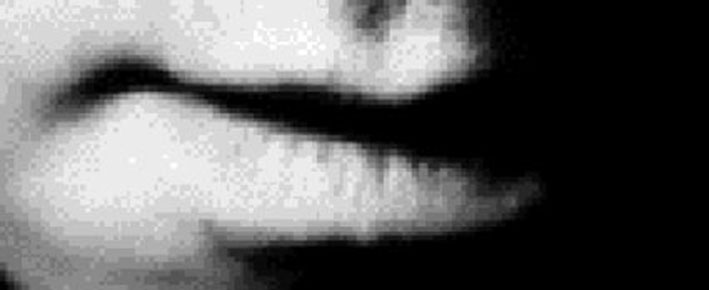
SPECCHIETTO per le ALLODOLE
1998Forte di Osoppo, Italy
Curated by Moreno Miorelli
Stairway leading to an underground chamber with two rectangular openings in the far wall. Each opening is blocked shut with a wooden box lined with stuffed black upholstery to absorb light and sound.
Each box has a small spyhole drilled through it.
From the left hole, closeup of the light from an oil-burning lamp.
From the right hole, closeup of a clear rotating cylinder lit from inside stained with Duncan's blood.
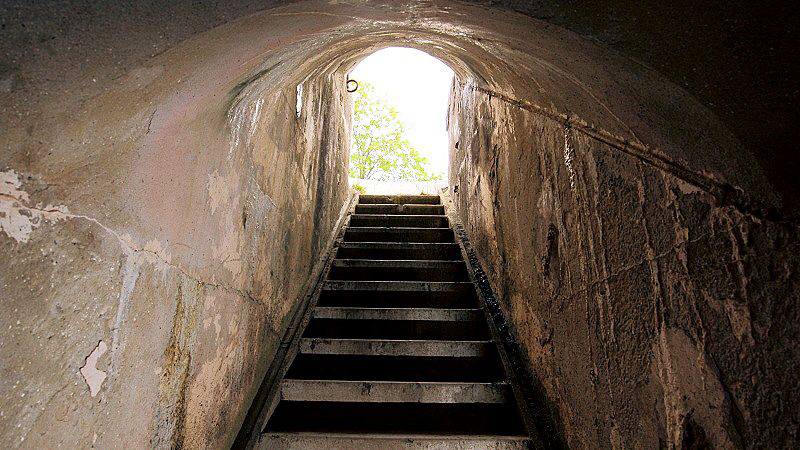
SWEAT CELL I / II
(ZNOJILE CELICA I / II)
1997TRANSVERZALA UTRINKOV Festival
Znojile, Slovenia
Two-part solo installation in a mountain village inside storage cells built of stone with dirt floors, using objects and materials found at the sites.
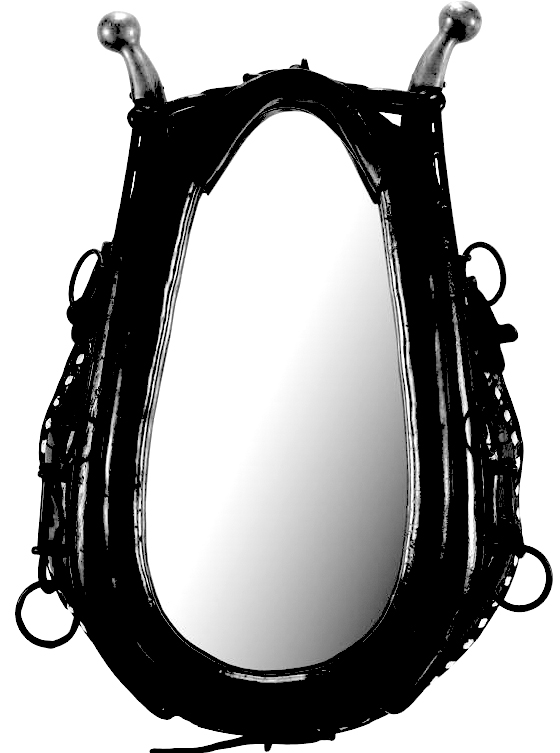
STRESS CHAMBER
1996Ars Electronica Contained: Rearview Mirror to Reality (photos)
Curated by Just Merit
Lighting design by Andries Olyslager
1995
Solo installation at Contained
Voest Alpine Steelmill, Linz
Curated by Just Merit
1993
Absolute Threshold Machine Festival, Amsterdam
Curated by Eric Hobijn
A shipping container equipped with motors mounted on three sides. Each motor has an eccentric flywheel attached, causing it to vibrate the wall it's mounted on at the container's resonant frequency.
Each participant is told to strip completely and enters the container alone, nude.
The participant is then locked inside, nude and completely blind.
All motors working together, controlled by the operator, create standing waves that the participant can feel as a tangible object moving at random inside the container, around and through the participant's body.

Installation photo © Giuliana Stefani
Detail photo © Claudia Hutter
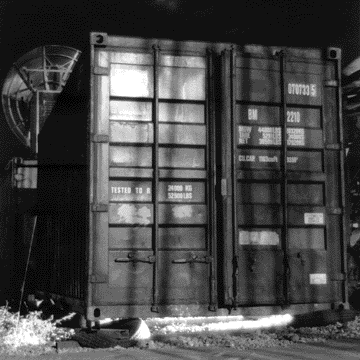
MAZE
1996Narrenturm Museum for Pathological Diseases, Vienna
Installation with video projection of MAZE in a cell of the museum, built in the 17th Century as a mental hospital. Viewers are chosen at random from the attending crowd, led into the dark, unventilated cell (originally designed for disturbed patients) and locked inside by the museum director. When the screening is over, the director unlocks the door and allows the viewers to leave.
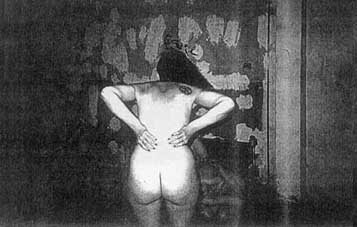
ICONS
1995Macro-closeup photographic prints 4 meters high of the vaginas of six women, shot in infra-red black-and-white film (translating body heat into light) with brush-drawings of the images drawn in Duncan's blood
Installation photo © Lee Thompson
The BLACK ROOM
1980American Hotel, Los Angeles
One room of a cheap hotel for transients is painted gloss-black.
The closet door vibrates violently from an invisible electric sander mounted to it on the inside.
Hanging near the window on the opposite wall is a framed, typed page with this text:
We hate you little boy. We hate you little boy. We hate you little boy. We hate
you little boy. We hate you little boy. We hate you little boy. We hate you little
boy. We hate you hate you hate you hate you hate you hate you hate you hate you
hate you hate you hate you hate you hate you hate you hate you hate you hate you
hate you hate you.
We saw you all covered with our blood. We saw you piss
and shit all over yourself. We cleaned you up, put food in your fucked-up little
mouth. We kept you alive, you ungrateful little bastard. We gave you our tit whenever
you wanted it, you little bloodsucker. We taught you everything you know. We always
knew you'd be ungrateful. We always knew you'd be half-human baggage. You're a
blight on our lives; we're tired of putting up with you. Ugly little body with
the sex exposed. You're utterly disgusting. How can you possibly live with yourself.
You're taking up our air, you little grease-spitter. Just look at the mess you've
made of everything. Look at all the horror. Every bit of it is your fault. A dog
could have done a better job. We should have put a pillow over your face when
we had the chance. We always knew you'd be a stunted growth, a walking turd, just
like the rest of your kind. Why don't you do everyone a favor and kill yourself.
We love a man in uniform. Die, you tit-sucking zombie. Wounded men are so romantic.
Go out and blow your head off, prick. We are fed up. Just go out and die.
DIE DIE DIE DIE DIE DIE DIE DIE DIE DIE DIE DIE DIE DIE DIE DIE DIE DIE DIE DIE
DIE DIE DIE DIE DIE DIE DIE DIE DIE DIE DIE DIE DIE DIE DIE DIE DIE DIE DIE DIE
DIE DIE DIE DIE DIE DIE DIE DIE DIE DIE DIE DIE DIE DIE DIE DIE DIE DIE DIE DIE
The TOILET EXHIBITION
1985Selected men's public toilet stalls, Tokyo
Sponsored by AQM, Tokyo
Solo installation of A1 poster-size collage-images of war atrocities and pornography, mounted on the doors inside stalls of mens' public toilets in the fashion, financial, government and entertainment centers of Tokyo: Shibuya, Hibiya, Kokkaigijidomae, Shinjuku.

The DREAM ROOM
1982Daily Planet Gallery, Tokyo
Solo installation of 2 meter (6 ft.) high brush-drawings from Duncan's dream notebooks made in sumi-e ink on paper that, except for a single doorway, completely covers all walls of the room.
Destroyed at the close of the exhibition.
Also included: PRAYER video
Image: WATCHING AND LEARNING collage
© John Duncan 1983
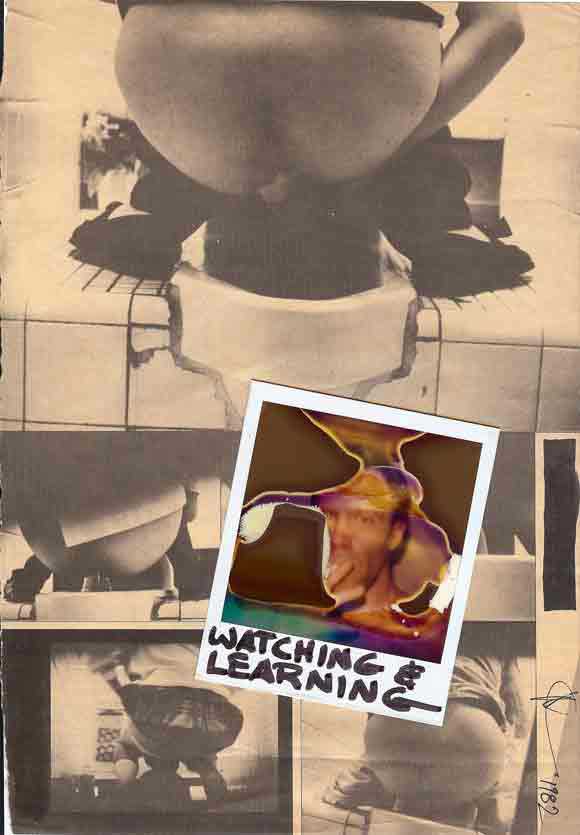
DESERT LANDMARK - SUCCULENT MAZE
1978 - 1980Mojave Desert, California
A living monument to women.
A 90,000 square foot aerial landmark in the form a labyrinth (image above), formed by planting seeds of Yucca brevifolia (Joshua Trees) at a barren site in the Mojave Desert. Later the seeds grow into a patterned grove of cactus trees, rough or sharp when touched, that produce flowers for a few days each year and provide year-round shade from the intense desert heat.
Site selection, seed collection, surveying, ground-breaking and planting is performed by Duncan alone, and completed on 1st January, 1980.
Currently growing wild
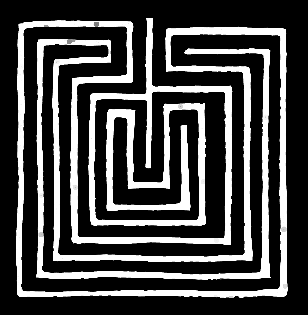
BUS RIDE
1976"Repressed sexual impulses give rise to authoritarian behavior."
W. Reich, M.D.; The Mass-Psychology of Fascism
A small amount of fish extract is poured into the ventilation system of a Los Angeles city bus shortly before the bus begins its standard route. Set in buses with windows that cannot be opened, the subliminal odor acts as a subtle aphrodisiac on the unsuspecting passengers.
Performed twice, 30 days apart:
A normally passive commuter kicks a stranger, a pregnant woman, off of the seat they're sharing in order to put up his feet. This causes a fight among the other passengers, half of whom side with the commuter.
A group of normally quiet ultra-polite children, going home from a school specializing in disciplined behavior, tear college career ads from the inside of the bus, shred them and attack each other with the scraps (photo)
